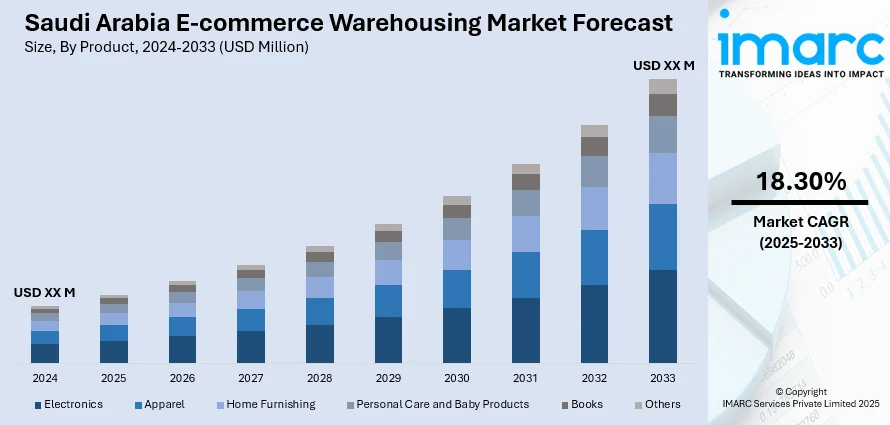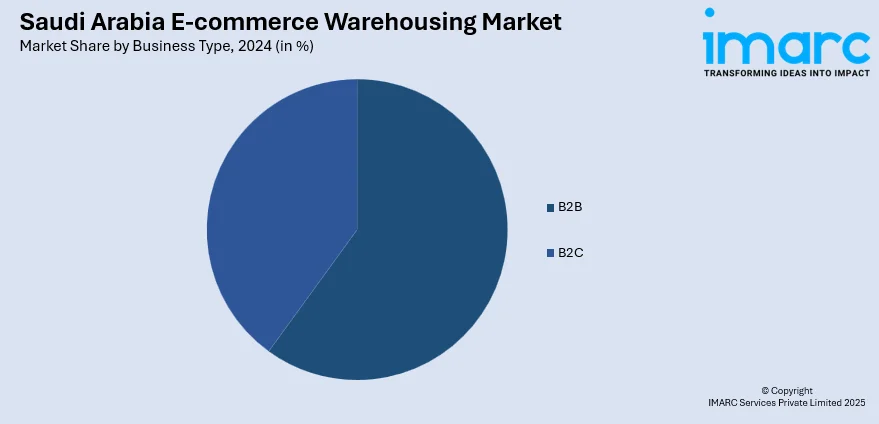
Saudi Arabia E-commerce Warehousing Market Size, Share, Trends and Forecast by Product, Business Type, Component, and Region, 2025-2033
Saudi Arabia E-commerce Warehousing Market Overview:
The Saudi Arabia e-commerce warehousing market size is projected to expand at a growth rate (CAGR) of 18.30% during 2025-2033. E-commerce businesses need contemporary warehouses to handle inventory, swiftly process orders, and guarantee quick delivery. This shift is encouraging both domestic and international logistics companies to invest in sophisticated warehousing facilities nationwide. Besides this, the growing utilization of the Internet of Things (IoT), which aids in enhancing efficiency, accuracy, and visibility across operations, is contributing to the expansion of the Saudi Arabia e-commerce warehousing market share.
|
Report Attribute
|
Key Statistics
|
|---|---|
|
Base Year
|
2024 |
|
Forecast Years
|
2025-2033
|
|
Historical Years
|
2019-2024
|
| Market Growth Rate 2025-2033 | 18.30% |
Saudi Arabia E-commerce Warehousing Market Trends:
Increasing adoption of online shopping platforms
The rising adoption of online shopping platforms is positively influencing the market in Saudi Arabia. The need for effective storage, sorting, and distribution systems is growing as more people are choosing to shop online due to its variety and affordable prices. This trend is also being aided by an increase in internet users, with more individuals making purchases online because of the ease of access to digital platforms. According to the DataReportal, at the beginning of 2024, Saudi Arabia had 36.84 Million internet users, with internet penetration reaching 99.0%. E-commerce companies require modern warehouses to manage inventory, process orders quickly, and ensure timely delivery. This shift is leading both local and international logistics providers to invest in advanced warehousing infrastructure across the country. Features, such as automation, real-time inventory tracking, and temperature-controlled storage, are becoming important to meet customer expectations. Moreover, government initiatives supporting digital transformation and improved logistics are creating a favorable environment for warehousing growth. The growth of sectors like fashion, electronics, groceries, and pharmaceuticals is further catalyzing the demand for specialized storage solutions. Consequently, warehouse operators are expanding their facilities and adopting technology to keep up with the growing e-commerce activities. The ongoing transformation of user behavior towards online shopping is strengthening the e-commerce supply chain, making warehousing a critical component in ensuring smooth operations and customer satisfaction across Saudi Arabia.

Growing adoption of IoT
The increasing use of the IoT is impelling the Saudi Arabia e-commerce warehousing market growth. As per the IMARC Group, the Saudi Arabia IoT market size reached USD 9,490.7 Million in 2024. As online shopping trends are rising rapidly, warehouses need to process higher volumes of orders quickly and with fewer errors. IoT devices, such as sensors and automated scanners, help track inventory in real time, reducing the chances of stockouts and overstocking. They allow warehouse managers to monitor goods from arrival to dispatch, ensuring better control over the supply chain. IoT also supports predictive maintenance of equipment by detecting faults early, which aids in avoiding sudden breakdowns and delays. Temperature and humidity sensors are especially valuable for storing sensitive items like food, electronics, and pharmaceuticals. With connected devices, warehouses can automate routine tasks, such as picking, sorting, and packing, which saves time and labor costs. Data collected from IoT systems enables better decision-making and demand forecasting. As Saudi Arabia is investing in digital infrastructure and adopting Industry 4.0, IoT is becoming a key driver in building smarter, faster, and more responsive e-commerce warehousing solutions that meet the rising expectations of online shoppers.
Saudi Arabia E-commerce Warehousing Market Segmentation:
IMARC Group provides an analysis of the key trends in each segment of the market, along with forecasts at the country and regional levels for 2025-2033. Our report has categorized the market based on product, business type, and component.
Product Insights:
- Electronics
- Apparel
- Home Furnishing
- Personal Care and Baby Products
- Books
- Others
The report has provided a detailed breakup and analysis of the market based on the product. This includes electronics, apparel, home furnishing, personal care and baby products, books, and others.
Business Type Insights:

- B2B
- B2C
A detailed breakup and analysis of the market based on the business type have also been provided in the report. This includes B2B and B2C.
Component Insights:
- Hardware Equipment
- Software
The report has provided a detailed breakup and analysis of the market based on the component. This includes hardware equipment and software.
Regional Insights:
- Northern and Central Region
- Western Region
- Eastern Region
- Southern Region
The report has also provided a comprehensive analysis of all the major regional markets, which include Northern and Central Region, Western Region, Eastern Region, and Southern Region.
Competitive Landscape:
The market research report has also provided a comprehensive analysis of the competitive landscape. Competitive analysis such as market structure, key player positioning, top winning strategies, competitive dashboard, and company evaluation quadrant has been covered in the report. Also, detailed profiles of all major companies have been provided.
Saudi Arabia E-commerce Warehousing Market News:
- In March 2025, Blue Ocean Global, a prominent entity in the e-commerce distribution sector, achieved a twofold increase in its business for 2024 compared to 2023, indicating a rising demand for online distribution in Saudi Arabia. Utilizing technology and innovation-led distribution, cross-border e-commerce, and advanced warehousing solutions, the firm aimed to transform the area’s online distribution scene by providing businesses with a streamlined and effective platform to expand operations, optimize inventory, and boost market presence.
- In June 2024, FirstCry, an e-commerce unicorn supported by SoftBank, aimed to grow its presence in the Middle East as it sought to implement its India strategy in international markets. The firm aimed to launch 12 new contemporary stores in the Kingdom of Saudi Arabia (KSA) along with new warehouses in Riyadh, Jeddah, and Dammam, KSA. The company planned to invest INR 72.6 Crore in establishing the new stores and INR 83 Crore in the new warehouses.
Saudi Arabia E-commerce Warehousing Market Report Coverage:
| Report Features | Details |
|---|---|
| Base Year of the Analysis | 2024 |
| Historical Period | 2019-2024 |
| Forecast Period | 2025-2033 |
| Units | Million USD |
| Scope of the Report | Exploration of Historical Trends and Market Outlook, Industry Catalysts and Challenges, Segment-Wise Historical and Future Market Assessment:
|
| Products Covered | Electronics, Apparel, Home Furnishing, Personal Care and Baby Products, Books, Others |
| Business Types Covered | B2B, B2C |
| Components Covered | Hardware Equipment, Software |
| Regions Covered | Northern and Central Region, Western Region, Eastern Region, Southern Region |
| Customization Scope | 10% Free Customization |
| Post-Sale Analyst Support | 10-12 Weeks |
| Delivery Format | PDF and Excel through Email (We can also provide the editable version of the report in PPT/Word format on special request) |
Key Questions Answered in This Report:
- How has the Saudi Arabia e-commerce warehousing market performed so far and how will it perform in the coming years?
- What is the breakup of the Saudi Arabia e-commerce warehousing market on the basis of product?
- What is the breakup of the Saudi Arabia e-commerce warehousing market on the basis of business type?
- What is the breakup of the Saudi Arabia e-commerce warehousing market on the basis of component?
- What is the breakup of the Saudi Arabia e-commerce warehousing market on the basis of region?
- What are the various stages in the value chain of the Saudi Arabia e-commerce warehousing market?
- What are the key driving factors and challenges in the Saudi Arabia e-commerce warehousing market?
- What is the structure of the Saudi Arabia e-commerce warehousing market and who are the key players?
- What is the degree of competition in the Saudi Arabia e-commerce warehousing market?
Key Benefits for Stakeholders:
- IMARC’s industry report offers a comprehensive quantitative analysis of various market segments, historical and current market trends, market forecasts, and dynamics of the Saudi Arabia e-commerce warehousing market from 2019-2033.
- The research report provides the latest information on the market drivers, challenges, and opportunities in the Saudi Arabia e-commerce warehousing market.
- Porter's five forces analysis assist stakeholders in assessing the impact of new entrants, competitive rivalry, supplier power, buyer power, and the threat of substitution. It helps stakeholders to analyze the level of competition within the Saudi Arabia e-commerce warehousing industry and its attractiveness.
- Competitive landscape allows stakeholders to understand their competitive environment and provides an insight into the current positions of key players in the market.
Need more help?
- Speak to our experienced analysts for insights on the current market scenarios.
- Include additional segments and countries to customize the report as per your requirement.
- Gain an unparalleled competitive advantage in your domain by understanding how to utilize the report and positively impacting your operations and revenue.
- For further assistance, please connect with our analysts.
 Request Customization
Request Customization
 Speak to an Analyst
Speak to an Analyst
 Request Brochure
Request Brochure
 Inquire Before Buying
Inquire Before Buying




.webp)




.webp)












